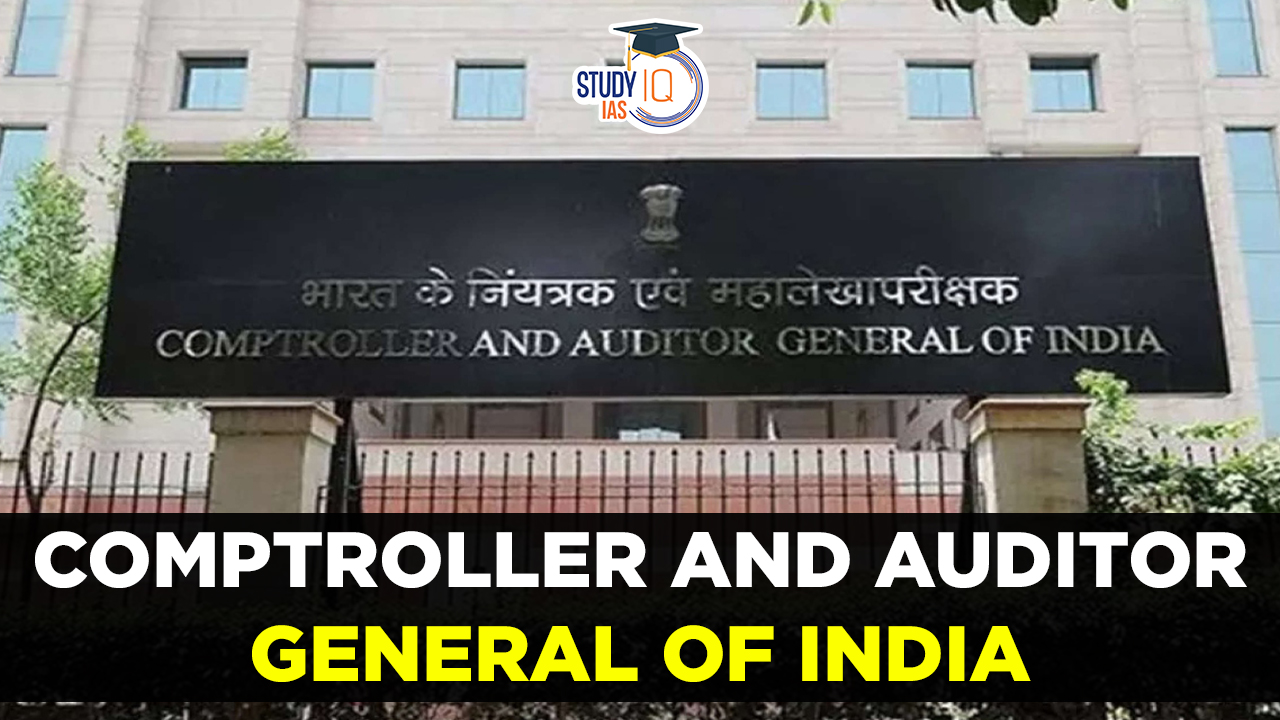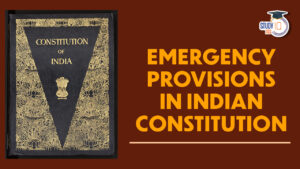Table of Contents
The Comptroller and Auditor General of India (CAG) is an independent constitutional authority responsible for auditing the accounts of the Union and State governments. The CAG ensures financial accountability, transparency, and efficiency in public expenditure. Check Out Details on the Comptroller and Auditor General of India (CAG) in this article.
Comptroller and Auditor General of India (CAG)
CAG is responsible for auditing all receipts and expenditures of the Union and State government, as well as those bodies/authorities that are substantially financed by the government.
| Aspect | Details |
|---|---|
| Established Under | Article 148 of the Indian Constitution |
| Duties & Powers | Defined in Article 149 |
| Form of Accounts | Governed by Article 150 |
| Audit Report Submission | As per Article 151, submitted to President/Governor |
| Appointment | Appointed by the President of India |
| Tenure | 6 years or until the age of 65, whichever is earlier |
| Removal Process | Same as Supreme Court Judges (impeachment process) |
| Types of Audits | Compliance Audit, Financial Audit, Performance Audit |
| Reports Submitted To | Parliament (Union Reports), State Legislatures (State Reports) |
| Committees Reviewing Reports | Public Accounts Committee (PAC), Committee on Public Undertakings (COPU) |
| Major Scams Exposed | 2G Spectrum Scam, Coal Block Allocation Scam, Commonwealth Games Scam |
| Challenges Faced | Lack of enforcement power, resource constraints, political interference |
Who is the Current CAG of India?
As of January 2025, the current Comptroller and Auditor General (CAG) of India is K. Sanjay Murthy. He assumed office on November 21, 2024, succeeding Girish Chandra Murmu.
Before his appointment as CAG, K. Sanjay Murthy, an Indian Administrative Service (IAS) officer of the 1989 batch, served as the Secretary in the Department of Higher Education, Ministry of Education, from October 1, 2021, to November 20, 2024. In this role, he played a pivotal part in implementing the National Education Policy 2020.
Constitutional Provisions for Tabling Reports
Article 151: Mandates the laying of CAG reports before Parliament or state legislatures but does not specify a timeline.
- Delays:
- Delhi government has withheld around 12 reports, some over four years old, leading to criticism and legal action by opposition parties.
- West Bengal has also delayed tabling CAG reports in the past.
- CAG reports cannot be published without being tabled in the legislature.
- The CAG’s reports are submitted to the President or Governor, who then table them in the Parliament or State Legislature.
Articles related to Comptroller and Auditor General of India
The Comptroller and Auditor General (CAG) of India is a constitutional office created under Articles 148 to 151 of the Constitution of India. Here’s an overview of the constitutional provisions related to the CAG:
| Constitutional Provision | Description |
|---|---|
| Article 148 |
|
| Article 149 |
|
| Article 150 |
|
| Article 151 |
|
| Article 279 |
|
Structure of CAG Office
The structure of the Comptroller and Auditor General’s (CAG) office in India is hierarchical, with various levels of authority and responsibility. Here’s a breakdown of the typical structure:
- Comptroller and Auditor General (CAG): The head of the Indian Audit and Accounts Department, responsible for overseeing all audit and accounting functions at the national level.
- Deputy Comptroller and Auditors General (Deputy CAGs): Assists the CAG in the management and coordination of audit activities. One of the Deputy CAGs usually serves as the chairman of the Audit Board.
- Additional Deputy Comptroller and Auditors General (Additional Deputy CAGs): Further assists in the management and coordination of audit activities, providing support to the Deputy CAGs.
- Directors General: These officials oversee specific directorates or divisions within the CAG’s office, focusing on areas such as financial audits, performance audits, and compliance audits.
- Principal Directors: Senior officials responsible for managing larger directorates or divisions within the CAG’s office, providing strategic direction and guidance.
- Directors/Deputy Directors: These officials lead individual audit teams or units, conducting audits, analyzing financial records, and preparing audit reports.
Additionally, at the regional level, there are Accountants General who act as representatives of the CAG, overseeing audit functions within specific states or regions. This hierarchical structure ensures efficient coordination, supervision, and execution of audit activities across various levels of government and public sector entities.
Comptroller and Auditor General Powers and Duties
-
Auditing: The CAG audits accounts related to the Consolidated Fund of India, the Consolidated Fund of each state, and the Consolidated Fund of each Union Territory with a Legislative Assembly. The CAG also audits transactions related to the Contingency Fund of India, the Public Account of India, and the Contingency Fund and Public Account of each state.
-
Preparing accounts: The CAG prepares annual accounts that show the receipts and disbursements for the Union, each state, and each Union Territory with a Legislative Assembly.
-
Ensuring financial accountability: The CAG audits government receipts and expenditures to ensure financial accountability.
-
Scrutinizing government expenditure: The CAG examines the efficiency, effectiveness, and economy of government expenditure.
-
Conducting performance audits: The CAG conducts performance audits to check the effectiveness of government policies and programs.
-
Verifying compliance: The CAG verifies whether government departments and agencies have complied with financial transaction regulations.
-
Examining revenue collection: The CAG examines the government’s revenue collection.
Roles of Comptroller and Auditor General of India
| Roles |
|
CAG Reports
The three CAG Reports outlined cover distinct aspects of public audits. Let’s delve into a concise overview of each:
- Audit Report on Appropriation Accounts: These accounts demonstrate how the money allocated by the legislature to various grants and expenditure heads has been utilized. The report assesses whether funds designated for specific purposes were indeed spent accordingly.
- Audit Report on Finance Accounts: These accounts detail the annual receipts and expenditures throughout the year.
- Audit Report on Public Undertakings: This report scrutinizes the financial operations and expenditures of various Public Sector Undertakings (PSUs).
In essence, the audit reports encapsulate instances of financial irregularities, losses, frauds, and wasteful expenditure. They also evaluate budgeting control accuracy, expenditure savings, etc. The reports, featuring audit “paras,” scrutinize public expenditures, with finalized paras presented to Parliament for review by relevant parliamentary committees.
The format of these reports undergoes periodic revisions while maintaining the primary objective of preventing financial loss. They spotlight transactions deemed financially unviable, keeping departments vigilant to avoid adverse publicity.
The procedural steps for creating and submitting an audit report by the Comptroller and Auditor General’s office include:
- Conducting audits and preparing “Inspection Reports” for each unit/organization, totaling about 72,000 annually. Copies are sent to the respective entities for corrective action, with significant matters included in Annual Audit Reports.
- Subjecting audit reports to rigorous quality assurance and counter-signing by the CAG before submission to the President.
- Submitting reports to the legislature, which delegates examination duties to relevant parliamentary committees, such as the Public Accounts Committee (PAC) and the Committee on Public Undertakings (COPU).
Since 1989, the CAG has also published Annual Activity Reports for each department, offering insights into their functioning and aiding in future planning.
The functions of the Comptroller and Auditor General of India encompass:
- Audit of Expenditure: Ensuring all expenditures from union and state revenues are audited, focusing on financial aspects and adherence to prescribed laws and procedures.
- Audit of Government Undertakings: Auditing commercial ventures of union and state governments, including departmental undertakings, statutory corporations, and government companies.
- Audit of Appropriation: Verifying that grants are utilized for intended purposes, detecting discrepancies, and ensuring adherence to legislative intentions.
Comptroller and Auditor General Significance and Criticism
The Comptroller and Auditor General (CAG) is a constitutional authority in many countries responsible for ensuring the government’s financial accountability and transparency. Its significance lies in its role as an independent body tasked with auditing government expenditures and revenues, ensuring they are in line with laws and regulations. Here’s a breakdown of its significance and criticism:
Significance
- Financial Oversight: The CAG plays a crucial role in examining government finances, ensuring that public funds are used efficiently and effectively.
- Transparency: By auditing government accounts and reporting irregularities, the CAG promotes transparency and accountability in public financial management.
- Checks and Balances: The CAG acts as a check on the executive branch’s financial decisions, providing an independent assessment of government spending and revenue collection.
- Recommendations: Through its audit reports, the CAG often makes recommendations to improve financial management practices, enhance efficiency, and prevent fraud and corruption.
- Parliamentary Accountability: The CAG submits its reports to the parliament or legislature, which can then review its findings and take appropriate action, including holding government officials accountable.
Criticism
- Timing and Delay: Critics argue that audit reports often take too long to produce, sometimes rendering them less relevant as the issues they highlight may have already been addressed or evolved.
- Limited Scope: Some critics suggest that the CAG’s focus is primarily on financial aspects, which may not capture broader aspects of governance, such as policy effectiveness or social impact.
- Resource Constraints: The CAG’s effectiveness may be limited by budgetary constraints and staffing shortages, hindering its ability to conduct thorough and timely audits.
- Political Interference: There are concerns that political pressure may influence the CAG’s independence, potentially compromising the integrity of its audits and reports.
- Limited Enforcement Powers: While the CAG can highlight financial irregularities, it often lacks direct enforcement powers, relying on other institutions to take action based on its findings.


 Indian Secularism: Constitutional Provis...
Indian Secularism: Constitutional Provis...
 India Mediation Campaign, Objectives, Pr...
India Mediation Campaign, Objectives, Pr...
 Emergency Provisions in Indian Constitut...
Emergency Provisions in Indian Constitut...





















